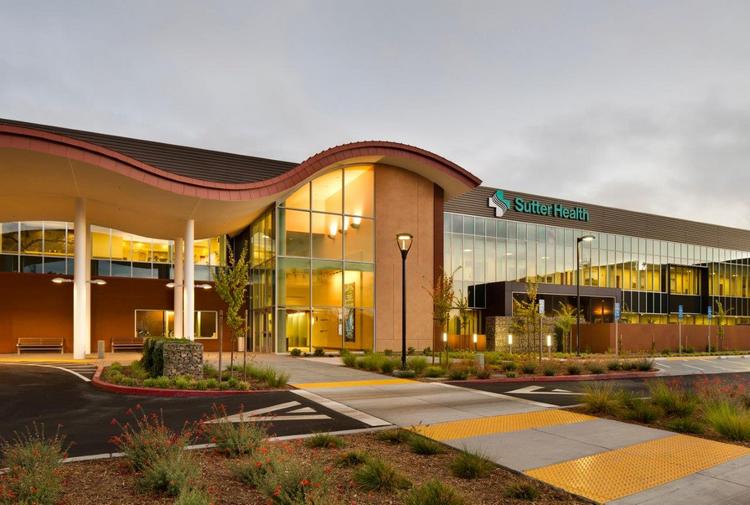Sutter Santa Rosa Regional Hospital has been awarded LEED Gold certification by the U.S. Green Building Council in recognition of the building’s energy-saving features and “green” construction—making SSRRH the first ground up built hospital to attain LEED Gold certification in Northern California. The hospital was designed by HGA and built by Unger Construction.
LEED is the USGBC’s rating system that recognizes buildings designed to reduce environmental impact and enhance operational efficiency. To receive LEED certification, projects must satisfy specific requirements such as reduction in energy use and incorporation of green building materials. Gold certification is the second highest of LEED’s four levels of certification for a new construction project.
“At Sutter Health, taking care of our patients goes beyond care within our hospital walls. Leading the way with sustainable practices impacts both human health and community well-being. We are very proud to be the first northern California hospital to play such a significant role in green building initiatives,” said Mike Purvis, chief administrative officer. “We applaud the efforts of our entire team for their work to help us achieve this important milestone that will benefit our surrounding area well into the future.”
As a regional priority, Sutter Health upgraded residential plumbing fixtures in the Larkfield housing area near the hospital site with low-flow alternatives to reduce water usage in the area. At the same time, Sutter supplies its own water for the hospital from a well on the property.
Other unique and LEED-compliant innovations at SSRRH include:
- Fuel Cell Technology power generation.
- A transportation systems master plan has been designed and implemented to increase carpooling and the use of high occupancy vans, as well as to reduce traffic impact on local access roads. A dedicated lane allows patients to bypass the Wells Fargo access road to reach the emergency room and there is a separate entrance for ambulance traffic.
- Greenhouse gas emissions during construction were reduced by powering down vehicles idling more than 10 minutes, helping to reduce the carbon footprint.
- Use of Recycled content in flooring and other building materials that provided minimal impact on landfills at the end of the structure’s life cycle.
- The selection of a sustainable building site and using compacted earth, rather than pilings, provided a solid foundation for the structure while eliminating noise pollution.
- Special parking areas are reserved for low GHG-emitting vehicles.
- Bioswales were built to channel runoff water into landscaped areas for collection and natural filtering before entering the storm drain system.
- Cool roof technology, comprised of white solar-reflecting products, have been deployed that do not add to the heat sink of the building. A heat sink is physically designed to increase the surface area in contact with the cooling medium surrounding it, such as the air.
- A highly efficient outdoor irrigation water system will reduce usage by 50 percent, aided by the selection of drought-resistant plants.
- Low-flow indoor water fixtures reduce internal water consumption by 34 percent.
- Recycling of construction materials met the minimum goal of 75 percent of all waste recycled.
- Forest Stewardship Council-certified wood products, obtained from socially and environmentally responsible sources, were used throughout the building. FSC is a non-profit international organization that sets standards and promotes responsible management of the world’s forests.
- Two electric vehicle recharging stations have been installed at the site.
- The energy efficiency of the building will reduce the load off baseline. Baseline is defined as the amount of energy that would be consumed annually without implementation of energy conservation measures based on historical metered data.
- The north facing positioning of the structure will reduce heat gain and the load on mechanical systems.
- South and east-facing portions of the building use high performance glazing on exterior surfaces to reflect heat (20 percent better than baseline while also using 20 percent less energy than a typical hospital of comparable size).
- Internal envelope air quality is enhanced through the use of low-volatile organic compound adhesives, paints and coatings.
- Natural lighting has been maximized in public spaces and corridors, further reducing energy needs while increasing the aesthetic beauty of the building.
- Interior noise is reduced using Quiet Rock gypsum wall board, delivering higher noise reduction between rooms, as well as by installing sound-absorbing ceiling tiles and wall panels in areas adjacent to patient rooms.
- High-efficiency fans and motors, with variable air volume controls, provide 100 percent ventilation without a continuous flow, reducing energy requirements.
“Whether through our recycling programs, fuel cell power generation plant, green building practices or LEED Gold certification, Sutter Santa Rosa Regional Hospital is committed to enhancing both patient care and energy efficiency with minimal impact on the surrounding environment,” said Tom Minard, senior project manager.
For more information on the new Sutter Santa Rosa Regional Hospital, visit www.suttersantarosa.org.
Photo courtesy of Ed Aiona.





